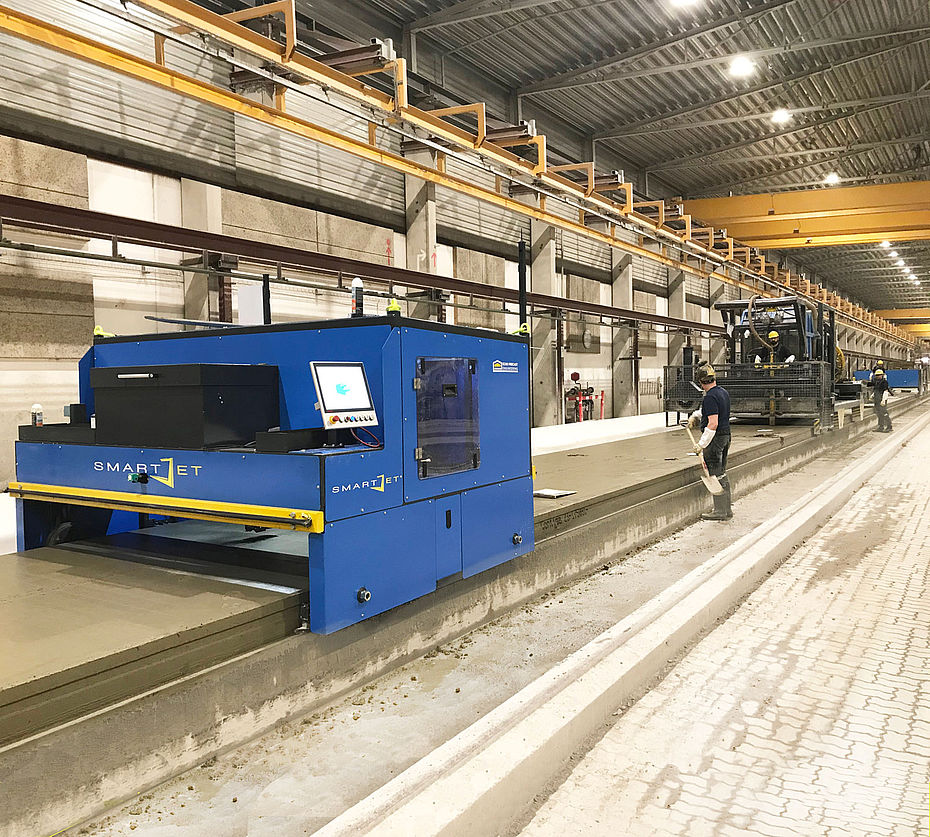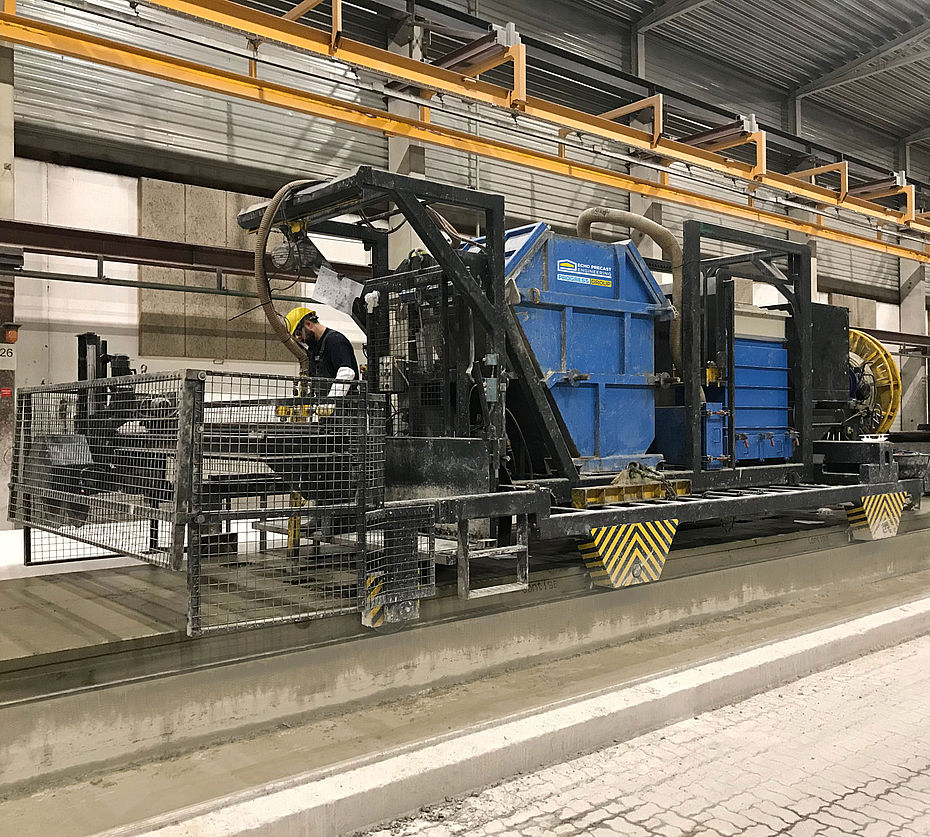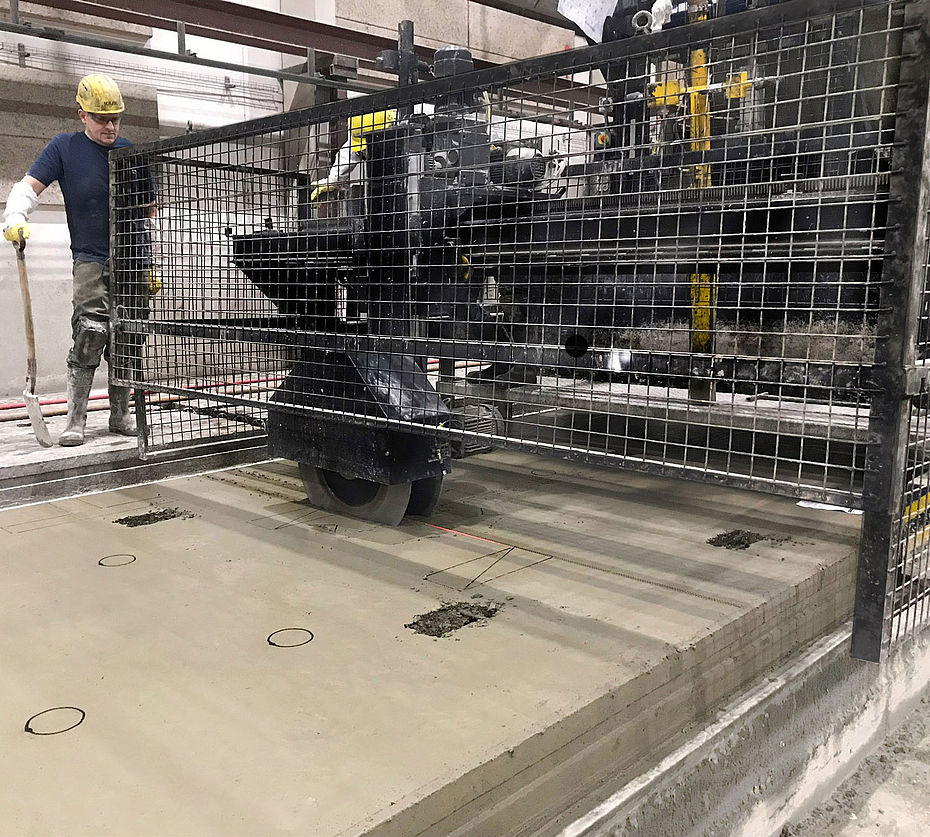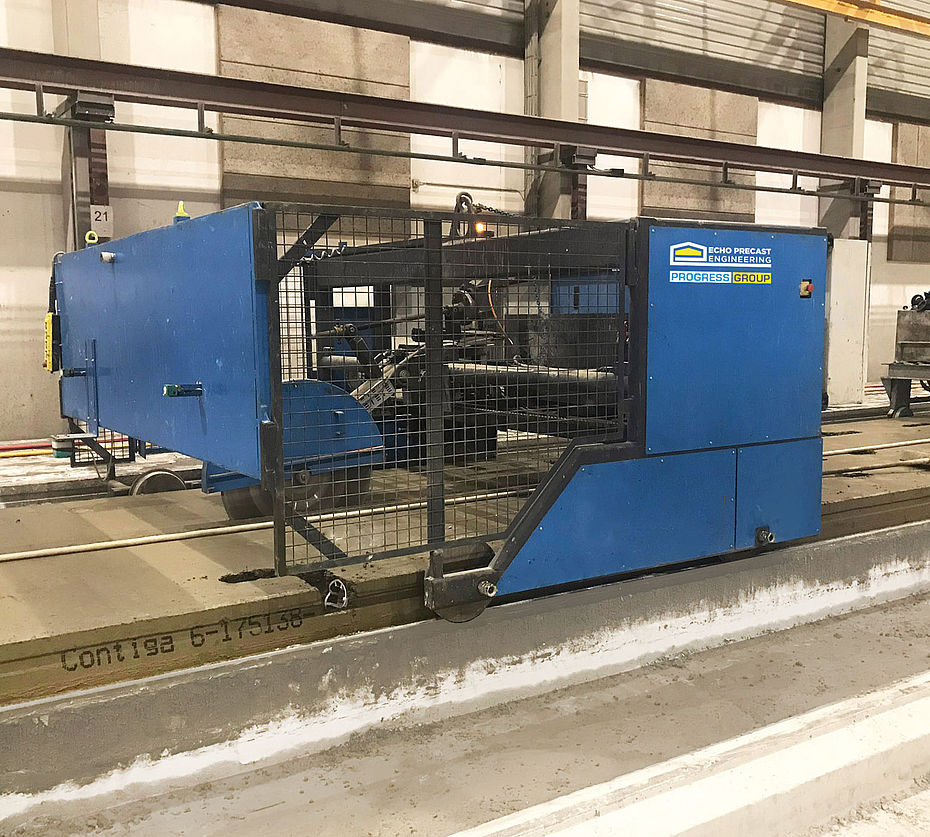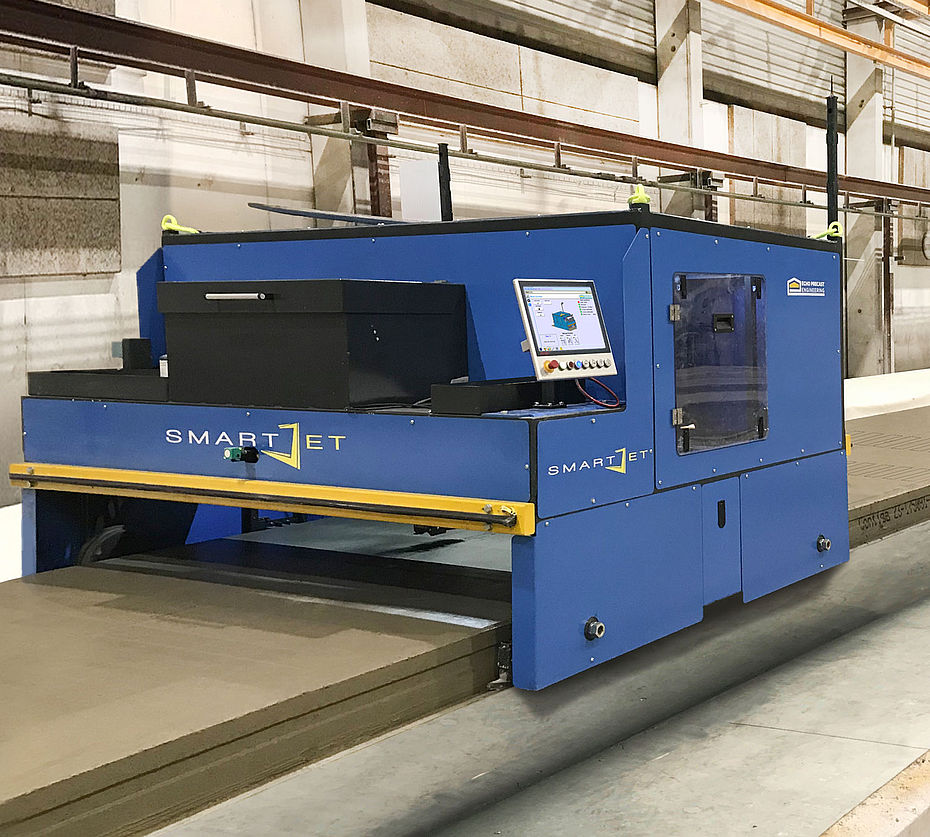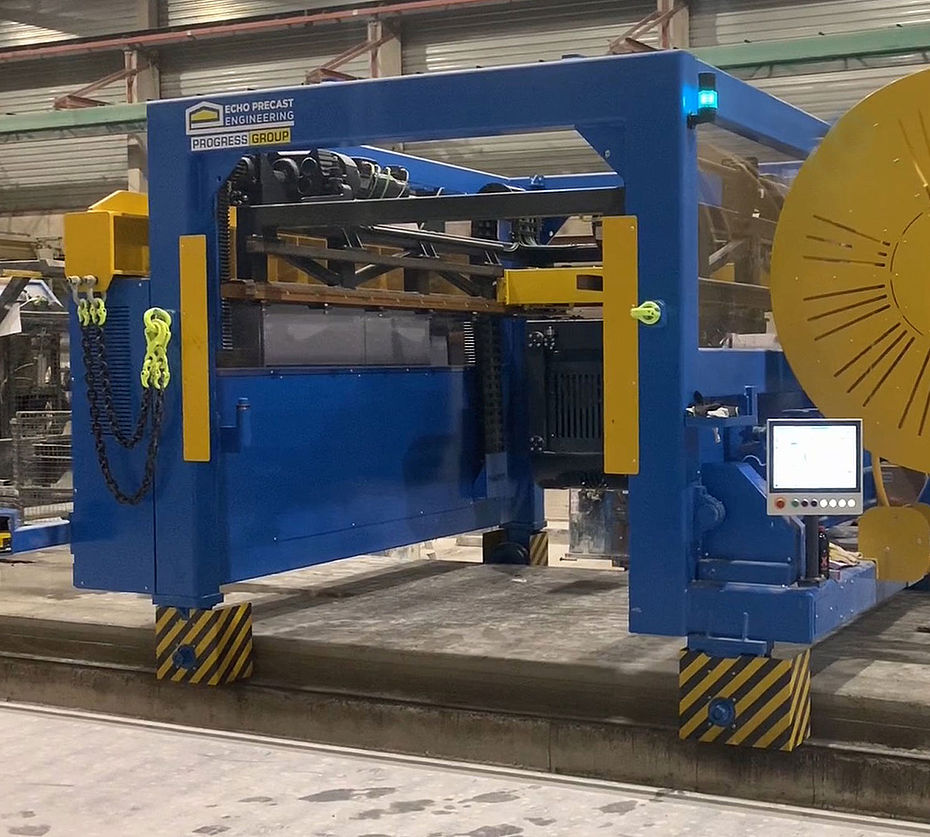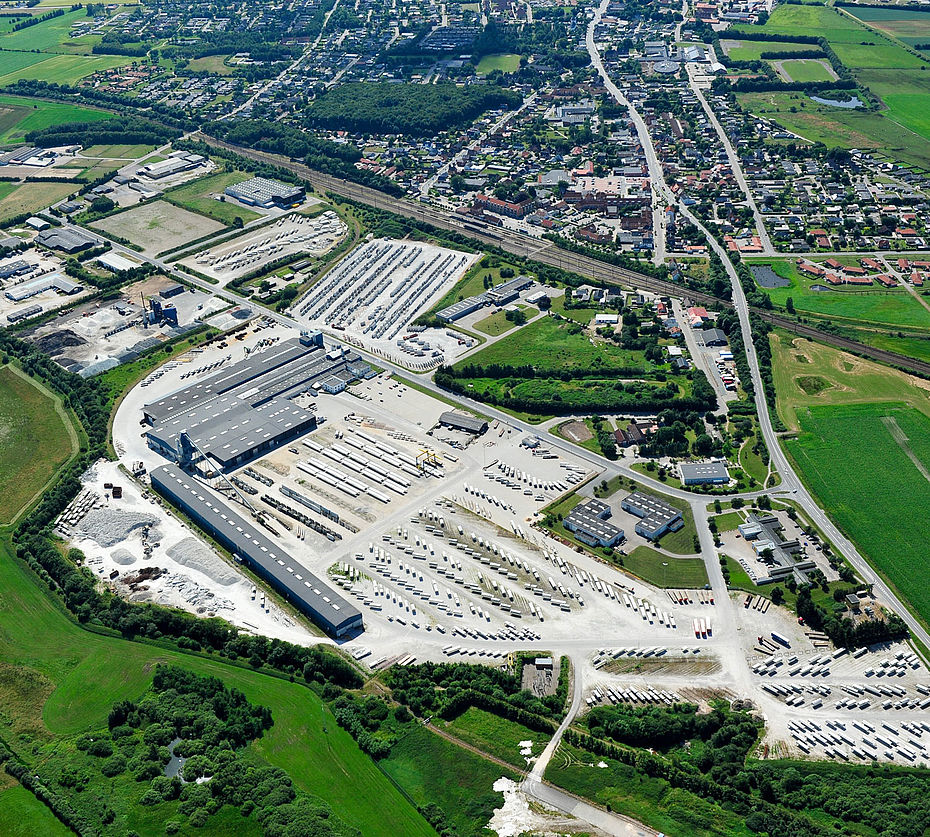Contiga: Automation and “Line Detection” technology
“Line Detection” technology enables very high precision in the production of hollow core slabs
Contiga A/S, located in Tinglev, in the south of Denmark, takes its production of hollow core slabs to a new level, with machinery and equipment from Echo Precast Engineering. For the first time, the completely newly patented "Line Detection" technology is being used, in which the Plotter SmartJet leaves a mark as a separate reference point on the slab. In this way, the Multi-angle Sawing Machine MAS can work out the geometry of the slab with highest precision. The result is a hollow core slab that easily meets today's demands on functionality and accuracy of fit.
Contiga A/S, a company of the HeidelbergCement Group, has over 35.000 m2 of production facilities and is one of the biggest production factories gathered in one place in Scandinavia that manufactures high-quality precast concrete elements and hollow core slabs for building construction. The company, which has its headquarters in Tinglev in the south of Denmark, not far from the border with Germany, naturally also supplies its products to the neighbouring country, which is also a highly competitive market. In addition to quality and price, what counts in competition is a powerful and efficient production facility that enables the necessary product quantities to be supplied in short delivery times.
In order to be one step more into the industry revolution 4.0, which is about increase of efficiency on the factory's own production of hollow core slabs and thus savings of costs, the management decided to invest in highly automated plant technology. The internationally renowned machine manufacturer Echo Precast Engineering, a company of the Progress Group and headquartered in the Belgian city of Houthalen, was chosen as the supplier of the equipment.
We needed a supplier that could offer reliable, strong service and support, as well as innovative, standardised plant engineering based on proven and tested technology. That is why we chose Echo Precast Engineering
Karsten Rewitz, , CEO of Contiga A/S
Universally applicable concrete aspirator
After handing over the task definition, inspection of the production halls and detailed consultation, the list of the necessary machines and the deadlines for delivery, assembly and commissioning were soon drawn up: The scope of supply included a universal Concrete Aspirator (CA) for Contiga's production beds of varying widths, an automated Fresh Concrete Saw (FCS), able to cut the crossbars in the fresh concrete, a Multi-angle Sawing Machine MAS and two automatic plotters SmartJet – one of them (2.4 m) equipped with the newly developed "Line Detection" technology with UV ink, which can significantly increase the precision of the markings on the hollow core slabs and the subsequent finishing of cuts, openings and recesses by the saw. The above mentioned machines were also intended to replace outdated technology in some cases.
Delivery was carried out in three stages: First, the universally applicable concrete aspirator reached the plant in Tinglev. As desired, the machine can be used on all of Contiga's existing production beds for hollow core slabs, both on the 1.2 m and 2.4 m wide beds.
Echo Precast Engineering was able to meet the requirement that the machine should be universally applicable by designing two basic frames with different widths – one of the two frames fits on the 1.2 m wide beds, one on the 2.4 m wide beds. Depending on current requirements, the concrete aspirator is placed and mounted on one or the other frame and can then be used on the correspondingly wide production bed.
Extracting concrete from recesses and openings and interface cleaning
The Concrete Aspirator CA is used to remove fresh concrete from areas that the plotter has previously marked on the slabs, especially for recesses or openings. The machine also removes concrete from areas of a slab in which the reinforcement is to be exposed, e.g., in order to use it as connecting reinforcement, thus enabling a constructive connection of the component with an adjacent component on the construction site. And finally, the aspirator is used for cleaning and removes excess concrete from cut-out surfaces or from gaps between two slabs adjoining each other on the production bed.
For the above-mentioned purposes, the machine is equipped with a slewing arm with a suction nozzle and associated pump that conveys the concrete through a hose into a waste container. The specially requested container can hold a total of 2,000 litres of concrete. It must then be emptied – for this purpose, a powerful forklift truck can lift the container off the machine at a lifting eye provided for this purpose and place it back on the machine.
Thanks to a spring suspension, the operator can move the suction device freely in longitudinal and transverse direction. The platform on which the operator moves with the nozzle during the suction process is also height-adjustable; i.e. the distance between the platform and the hollow core slab or production bed can be increased or decreased, so that handling is ergonomically comfortable for the operator.
Saw for partial cuts
What is innovative about the concrete aspirator at Contiga is that at the front – i.e. in the cross to the direction of travel – a so-called “Double Cut Saw” is additionally mounted on each of the two base frames. This sawing machine can make cuts in fresh concrete at 90° and up to a depth of 20 cm.
Contiga carries out these "partial cuts" in slab areas where a connection between the element and a wall element is later made during assembly on site. The double cut saw only cuts the concrete from the upper half of the hollow core slab; the lower half, where the reinforcement for the pre-stressing is located, remains untouched.
Afterwards the operator can remove the concrete manually or with the help of the Concrete Aspirator CA.
In a second step, when the concrete is cured, the slab can be split with the help of a sawing machine.
The Double Cut Saws on the base frames of the concrete aspirator are powered directly from the concrete aspirator.
Fresh concrete saw FCS also cuts through transverse reinforcement
The second delivery from Houthalen in Belgium to Tinglev in Denmark took place six months later. It included the ordered Fresh Concrete Saw (FCS).
The FCS is designed for the 2.4 m wide production beds at Contiga. It carries out longitudinal cuts in the fresh concrete in order to be able to produce hollow core slabs with smaller widths even on the wider beds by cutting off excess concrete.
A special feature of the fresh concrete saw at Contiga is that it also cuts through reinforcing bars inserted into slabs in transverse direction. These so-called “cross bars” are often embedded in the slabs in Denmark for crane transport and for reinforcement of the hollow core slab. For this purpose, the saw has a very high torque. This means that the cross bars can be cut without the movement of the saw displacing the bars in the fresh concrete and moving them from their exact position in the precast concrete slab.
By equipping the factory with this machine, the plant saves time, energy and the cost of steel blades of a saw machine for cured concrete.
Automatic plotters with "Line Detection" technology
The last part of the delivery, which arrived in Tinglev in December 2019, were the 1.2 plotter and the 2.4 plotter SmartJet with additional printhead for the line detection and the fully automatic MAS (Multi-angle Sawing Machine). The plotter is a dynamic asset in a production plant because it makes precise drawings on the hollow core slabs – lines for cut-outs, numbers or simple cutting lines.
The plotter SmartJet for the 2.4 m wide production beds features the so-called "Line Detection" technology, newly developed by Echo Precast Engineering, which ensures high precision when applying for saw cut lines.
With this smart technology, the plotter draws the markings on the slab with special ink that later on can be detected by the saw in order to position itself.
With the special ink mark the machine sets a new zero or reference point for each cut. The downstream processing machine, e.g., the multi-angle sawing machine, uses its special sensor to detect the marking and aligns the position of the respective cut accordingly. This procedure makes it possible to achieve maximum precision.
Traditional downstream processing machines, i.e. saws and aspirators, use only the usual laser systems or encoders to calculate their position on the casting bed. These procedures are prone to errors. The laser system will not take into account any shrink or displacement which happen after de-tensioning. And the encoders calculate the position based on the rotation of the wheels of the machine. As wheels can spin due to dirt on the rails with concrete residues, for example, exact positioning is then no longer possible.
The entire data exchange between the computers of the plant control system and the PLC of the, saws and plotters at Contiga is carried out via a wireless system. This means that the planning data for markings or cuts and extraction processes are transmitted wireless to the respective machine via a local Wi-Fi radio network.
The automatic plotter can register for example a defect or a slab can be repositioned by the operator if needed. The plotter, after finishing its work, can send the actual produced file back to the network of Contiga. This file will be checked in the planning department and further send to the sawing machine with updated report of the disposition of the marking.
The data is transmitted in the open PXML file format, which stands for Progress XML and ensures compatibility with other software solutions used in the plant. Alternatively, USB ports are available for data transfer.
Multi-angle sawing machine also for diagonal cuts
The Multi-angle Sawing Machine MAS can be used on all 2.4 m wide production beds at Contiga. The MAS cuts cured pre-stressed concrete slabs to the desired length. It can make 0° and 180° cuts and also angle cuts between 90° and 0° or angle cuts between 90° and 180°.
The sawing speed is regulated automatically by the electronic power control of the saw motor. This machine can cut hollow core slabs from 12 to 50 cm high.
The MAS is also moved by an electric motor. The cable for the power supply is in turn wound up or unwound by means of a drum.
It is a powerful machine; it has integrated line detection to work automated where it detects the marking lines made by the plotter.
This machine works online and can receive the remote support from the technical team of Echo Precast Engineering when it is necessary.
Safety sensors
Since the MAS can work automatically, it is equipped with safety sensors. Like this, it detects any obstacle or person in its path and pauses production until the obstacle has been removed. This prevents crashes and accidents as well.
A relationship of trust
Contiga CEO Karsten Rewitz is very satisfied with the delivered customised technology and the service of Echo Precast Engineering. "The machines were delivered even earlier than originally agreed upon. This was done without any problems after we requested a shorter delivery time at a later stage".
Only the COVID-19 pandemic and the accompanying travel restrictions for technicians and trainers caused unpredictable, minimal delays in commissioning and training of the machine operators. But even these problems were solved quickly. "Service and cooperation are simply super," says Rewitz.
*Original article in CPI magazine


